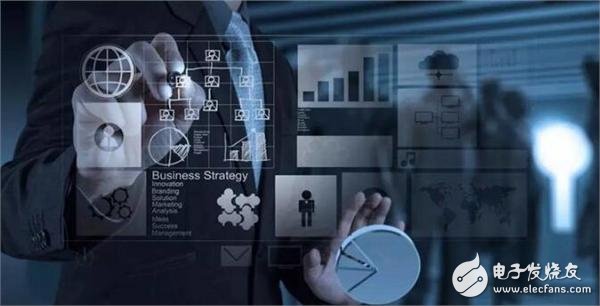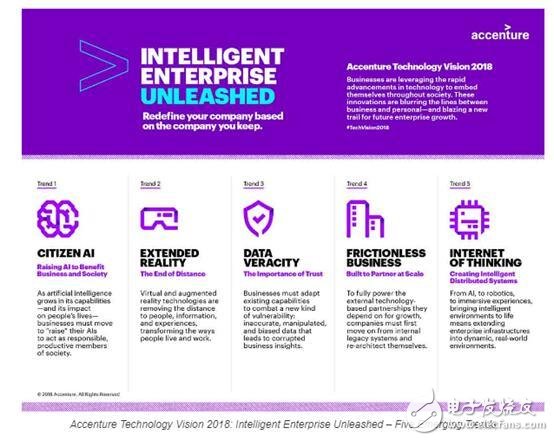According to Accenture's annual technical report Accenture 2018 Technology Vision, the rapid development of artificial intelligence (AI) and other technologies is accelerating the creation of smart enterprises and enabling companies to integrate into people's lives. The trend may subvert the business in the next three years. However, the use of growth opportunities and positive impacts on society requires a new era of leadership with a priority of trust and greater responsibility.

This year's report "Smart Enterprise: Redefining Your Company Based on Your Company" highlights the rapid development of technologies including artificial intelligence (AI), advanced analytics and cloud computing, enabling companies to not only create innovative products, services It also changes the way people work and live. This in turn changes the company's relationship with its customers and business partners.

As part of its technology vision, Accenture surveyed more than 6,300 corporate and IT executives worldwide. More than five-fifths of respondents (84%) agree that technology is being used, and companies are seamlessly integrating themselves into the way people live today.
For example, Amazon not only integrates its huge online business, but also its Echo device and artificial intelligence assistant Alexa into people's daily lives, so that developers will create a dedicated apartment locker for the new apartment portfolio, and People are giving the company physical access to their homes through their smart locking system, allowing couriers to deliver when no one is available.
“Technology is now firmly embedded in our daily lives and is reshaping most areas of society,†said Paul Daugherty, chief technology and innovation officer at Accenture. “As a city that develops around ports and railways, or people rebuild their lives around electricity. Similarly, today's world is reimagining around digital innovation and ultimately pushing companies that offer these services. This requires building new relationships based on trust and sharing of vast amounts of personal information."
The report points out that this latest technological change is unique, because change is two-way. This is the first time; people not only use the company's products and services, but also provide them with information and access. This level of “integrated innovation†and trust requires a deeper relationship, built on the company's products and built on its goals and values. This two-way partnership brings new responsibilities to consumers, business partners and society as a whole, and requires high-level leadership and commitment.
A savvy organization understands that these new social expectations can be translated into corporate power. They are leveraging their increased interaction to build partnerships with customers, employees, governments and the public. This is beyond the consumer or retail space.
For example, Tesla is working with governments to accelerate the development of guidelines for autonomous vehicles. Siemens is creating new partnerships and embedding itself into the architecture of its business partners by offering the MindSphere operating system for the IoT that can be used in a variety of assets, such as manufacturing equipment, smart grid components or power generation equipment.
The technology vision identifies the five emerging technology trends that companies must address if they are to build the partnerships needed to succeed in today's digital economy:
AI Citizenship: Improve AI to benefit businesses and society. As artificial intelligence (AI) grows in its capabilities, its impact on people's lives is also increasing. Companies wishing to take advantage of AI's potential must acknowledge this impact and “improve†AI as a representative of their business owners.
Expanding reality: the end of distance. Virtual and augmented reality technologies are transforming the way people live and work by eliminating distances from people, information and experience.
Data Accuracy: The Importance of Trust. By transforming itself to run data, companies are now faced with a new kind of vulnerability: inaccurate, manipulated and biased data that leads to impaired business insight and policy tilt. To meet this challenge, companies must follow a dual mandate to maximize accuracy and minimize the incentives for data manipulation.
Frictionless business: building partnerships on a scale. Businesses rely on technology-based partnerships to grow, but their own legacy systems are not designed to support partnerships on a large scale. In order to fully support the connected smart enterprise, the company must first redesign itself.
Internet thinking: Creating intelligent distributed systems. Enterprises have put a lot of effort into the smart environment through robotics, artificial intelligence and immersive experiences, but turning these smart environments into reality requires not only the addition of key skills and human resource capabilities, but also the current enterprise technology infrastructure. Modernization.
“By these new partnerships with customers, employees and business partners, the company is building greater trust and further integrating itself into society, becoming more and more indispensable and driving its own growth.†Daugherty said.
About methodology
The Accenture Technology vision is developed annually by Accenture Labs and Accenture Research. For the 2018 report, the research process included the collection of input from an external advisory committee on the Technology Vision, which consisted of more than 20 experienced people from the public and private sectors, academia, venture capital firms and entrepreneurial companies. In addition, the Technology Vision team conducted interviews with technical and industry experts and nearly 100 Accenture business leaders. At the same time, Accenture Research conducted a global online survey of more than 6,300 business and IT executives in 25 countries and 18 industries to gain insight into the adoption of emerging technologies. Surveys help identify key issues and priorities for technology adoption and investment. Respondents are primarily C-level executives and directors with annual incomes of at least $500 million, most of which have annual revenues of more than $6 billion, some of which are functional and business leaders.
Linear Array Sensor,Infrared Light Detector Device,Swir Linear Detector,Infrared Ingaas Sensor
Ningbo NaXin Perception Intelligent Technology CO., Ltd. , https://www.nicswir.com